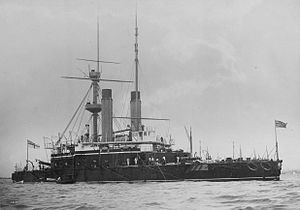Name HMS Nile Laid down 8 April 1886 Commissioned 30 June 1891 Launched 27 March 1888 Draft 8.69 m | Completed 10 July 1891 Construction started 8 April 1886 Length 105 m | |
 | ||
Fate Sold for scrap, 9 July 1912 | ||
HMS Nile was one of two Trafalgar-class ironclad battleships built for the Royal Navy during the 1880s. Late deliveries of her main guns delayed her commissioning until 1891 and she spent most of the decade with the Mediterranean Fleet. Nile returned home in 1898 and became the coast guard ship at Devonport for five years before she was placed in reserve in 1903. The ship was sold for scrap in 1912 and broken up at Swansea, Wales.
Contents
Design and description
The design of the Trafalgar-class ships was derived from the layout of the earlier ironclad battleship Dreadnought and the Admiral class, coupled with the heavy armour of the preceding Victoria class. The Trafalgars displaced 12,590 long tons (12,790 t); the addition of more armour and ammunition during construction added an additional 650 long tons (660 t) of weight and increased their draught by a foot (0.3 m) below their designed waterline. They had a length between perpendiculars of 345 feet (105.2 m), a beam of 73 feet (22.3 m), and a draught of 28 feet 6 inches (8.7 m). Nile's crew consisted of 537 officers and ratings in 1903 and 527 two years later. The low freeboard of the Trafalgars made them very wet and they could not maintain full speed except in a calm.
The ships were powered by a pair of three-cylinder, vertical inverted, triple-expansion steam engines, each driving one shaft, which were designed to produce a total of 12,000 indicated horsepower (8,900 kW) and a maximum speed of 16.5 knots (30.6 km/h; 19.0 mph) using steam provided by six cylindrical boilers with forced draught. During her sea trials, Nile slightly exceeded this with a speed of 16.88 knots (31.26 km/h; 19.43 mph) from 12,102 ihp (9,024 kW). The Trafalgar class carried a maximum of 1,100 long tons (1,118 t) of coal which gave them a range of 6,300 nautical miles (11,700 km; 7,200 mi) at a speed of 10 knots (19 km/h; 12 mph).
Armament and armour
The Trafalgar-class ships' main armament consisted of four breech-loading (BL) 13.5-inch (343 mm) guns mounted in two twin-gun turrets, one each fore and aft of the superstructure. Each gun was provided with 80 rounds. The muzzles of these guns were only 3 feet 6 inches (1 m) above the deck, and were very hard to fight in a seaway due to the spray breaking over the forward turret.
Their secondary armament was originally planned to consist of eight BL 5-inch (127 mm) guns, but these were replaced during construction by six quick-firing (QF) 4.7-inch (120 mm) guns. 200 rounds per gun were carried by the ships. Eight QF 6-pounder (2.2 in (57 mm)) and nine QF 3-pounder (1.9 in (47 mm)) Hotchkiss guns were fitted for defence against torpedo boats. The ships carried four 14-inch (356 mm) torpedo tubes and another pair were added in August 1890.
The Trafalgars' armour scheme was similar to that of Dreadnought, although the waterline belt of compound armour did not cover the complete length of the ship and a 3-inch (76 mm) deck extended fore and aft of the armoured citadel to the bow and stern. The belt was 230 feet (70.1 m) long and was 20–14 inches (508–356 mm) thick; it was closed off by traverse 16–14-inch (406–356 mm) bulkheads. Above it was a strake of 18–16-inch (457–406 mm) armour that covered the bases of the gun turrets. Another strake above that protected the secondary armament and was 5–4 inches (127–102 mm) thick. The sides of the gun turrets were 18 inches thick and the conning tower was protected by 14-inch plates.
Construction and career
Nile, named after the Battle of the Nile, was the third ship of her name to serve in the Royal Navy. She was laid down on 8 April 1886 by Pembroke Dockyard. The ship was launched on 27 March 1886 by Mrs. Maud Hamilton, wife of Lord George Hamilton, First Lord of the Admiralty. She was completed in July 1890, although her main guns were not delivered until the following year, at a cost of £885,718.
After delivery, she was commissioned at Portsmouth on 30 June 1891 for manoeuvres, following which she was assigned to the Mediterranean Fleet. When the battleships Victoria and Camperdown collided on 22 June 1893, Nile was next astern and it was only through the skillful manoeuvring of Captain Gerard Noel that his ship was not also involved in the collision. Nile had her 4.7-inch guns replaced by QF 6-inch (152 mm) guns in 1896. She came home in January 1898 to become the port guardship at Devonport, and Captain Robert Rolleston was in command in June 1902. In February 1903, the ship was relegated to the reserve at Devonport, where she remained until she was sold on 9 July 1912 for £34,000 to be broken up at Swansea by Thos W Ward.
